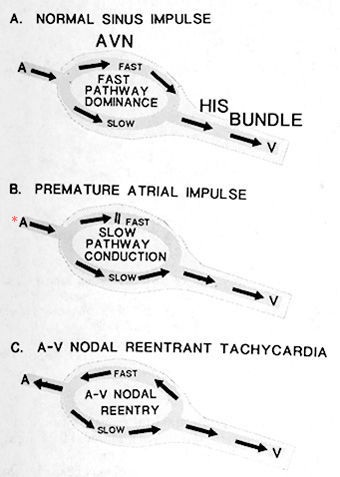
Figure 1
Mechanism of paroxysmal
supraventricular tachycardia (PSVT) due to AV nodal reentry.
PSVT due to AV nodal reentry is due to the presence of dual AV nodal pathways
with different conduction properties and refractory periods (unable to
be stimulated by atrial impulse due to transient altered electro-chemical
changes). These pathways have critical components in the atrial approaches
to the AV node.
A. During sinus rhythm in the presence of dual AV nodal pathway
the fast pathway (with a longer refractory period) is primarily responsible
for AV transmission because of slower propagation in the other pathway.
B. A premature atrial impulse blocks in the fast pathway because
of its longer refractory period and propagates down the slow pathway,
prolonging the PR interval and allowing retrograde invasion of the fast
pathway because its tissue remains polarized because of the block of the
descending impulse.
C. Echo beats or Av nodal reentrant tachycardia will occur when
the time relationships between slow pathway conduction and recovery of
excitability at the site of block in the fast pathway allow the impulse
to reenter the slow pathway after retrograde fast pathway transmission.
The atria are also activated retrogradely. Radiofrequency energy for slow
pathway, ablation therapy is applied at the site indicated by the asterisk.